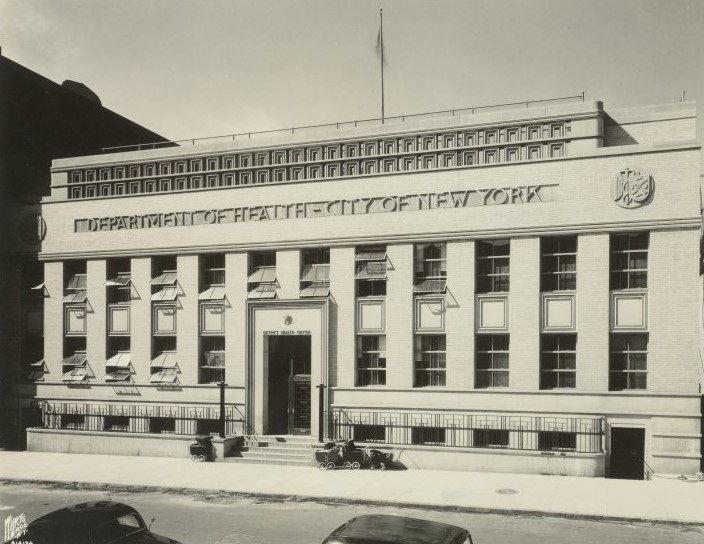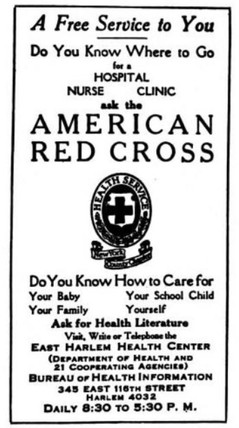East Harlem Health Center
Introduction
Text-to-speech Audio
The Art Deco style, buff brick building at the corner of 158 E. 115th Street and Lexington Avenue opened in June 1937 as the East Harlem Health Center. The health center was the first city-owned and city-built health center in Manhattan. It was authorized by Mayor Fiorello LaGuardia in 1935 and funded by Washington's New Deal Public Works Association. Originally two stories tall with a rooftop playground, two more stories have been added, recessed on top of the roof, as well as a two-story addition on the corner with Lexington Avenue. The building is part of the 90-acre East Harlem Historic District, listed in the National Register of Historic Places in 2019.
Images
Undated photo of East Harlem Health Center by Wurtz Bros. (NYPL)

American Red Cross 1922 calendar promoting E. Harlem Health Center (Widdemer 1925 p. 51)

Backstory and Context
Text-to-speech Audio
The East Harlem Health Center began operating in November 1921 at 343-345-347 E. 116th Street as a three-year experiment in coordinating health and family welfare work in a defined city area. The Health Department of the City of New York was aided by 22 cooperating agencies under the auspices of the American Red Cross. The Red Cross purchased the three buildings on E. 116th which were then renovated; the three-story buildings with basements combined to provide about 9.000 square feet. The goal was to provide one location where the multitude of local agencies could provide services rent-free, coordinate care, share equipment, and see where there were gaps in services offered. The Health Center drew its population of over 112,000 residents from 87 city blocks, roughly between E. 99th Street and E. 125th Street and between the East or Harlem River and Third Avenue. Over 100,000 of the residents were foreign-born or of foreign parentage, mainly from Italy. The most common occupations were factory worker, laborer, and petty tradesman. One of the first gaps was the lack of general medical examinations of healthy people; the Department of Health set up a clinic under its Bureau of Preventable Diseases. Executive Officer of the Health Center was Dr. Kenneth D. Widdemer.
After the three-year experiment was deemed a success, funds were obtained to continue the services. The East Harlem Health Center became the first of the city's administrative health centers in 1929. The Lower West Side, Red Hook, and Gowanus neighborhoods were added to the program, By 1939, the program had been extended to the whole city; nine new district health buildings had been built with Works Progress Administration funding and five more were being constructed.
Henry C. Pelton designed the new East Harlem Health Center building to be built on E. 115th Street but died in 1935 before it was completed. Pelton was a Columbia University graduate who also designed Riverside Church and St. Mary's Hospital for Children on 34th St. The health center is Modern Classic style and four stories tall with a partially raised basement. The original building was two stories tall with a basement and included an apartment. The basement is clad in streamlined granite and the upper floors are clad in light brick. The top of the main facade sports lettering that reads "DEPARTMENT OF HEALTH CITY OF NEW YORK" with roundels at either end. Two more stories were added on the rooftop later, recessed from the main facade. A two-story addition was built to the west of the original building, on the corner with Lexington Avenue.
The two-story limestone entrance from E. 115th Street with double doors was the only entrance when the building was first built. In 1937, the health center was located between Public School 57 and two tenement lots. A former exterior staircase led from the rooftop playground to the ground. The health center originally contained facilities to treat tuberculosis, maternal and child health, social and dental hygiene, and a general medical clinic. The center provided health education and instruction in public health for medical students. In 1942, the center undertook a massive effort to immunize children against diphtheria, ran a health education program to reduce infant mortality, and operated three child health stations, dental clinics, chest clinics, and a social hygiene clinic.
In the early 1950s, the basement apartment was converted into a boiler, storage room, work rooms, and a lecture room. The rooftop addition provided clinic space on the third floor and offices plus a laboratory on the fourth story. The corner addition probably was built in the early 1950s, too. The East Harlem Neighborhood Health Action Center opened in the building in 2017, providing direct health services to local residents. The building also houses non-profits like Harlem United. Although in-person activities are still suspended (as of Nov. 2021) due to covid, special events are planned (see link below).
Sources
Cohen, Miriam. Workshop to Office: Two Generations of Italian Women in New York City, 1900-1950. Ithaca, NY. Cornell University Press, 1992.
Ranney, Susie. "East Harlem Health Center," p. 52-53 in: Robins, Anthony W. Intensive-Level Historic Resource Survey of East Harlem, New York County, New York City. New York, NY. Thompson & Columbus, Inc. for Landmark East Harlem and CIVITAS Citizens, Inc., 2017.
Widdemer, Kenneth D. A Report of the First Three Years' Work of the East Harlem Health Center Demonstration. New York, NY. American Red Cross, 1925.
New York Public Library (NYPL) Digital Collection, Photos of NYC: https://digitalcollections.nypl.org/items/510d47e2-cff7-a3d9-e040-e00a18064a99
Google Books
